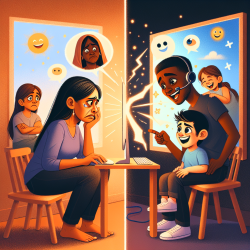Introduction
In the realm of speech language pathology and online therapy services, understanding the nuanced perspectives of young people is crucial for effective intervention and support. The research article, ‘Young People Just Resolve It in Their Own Group’: Young People’s Perspectives on Responses to Non-Consensual Intimate Image Distribution, provides valuable insights into how young individuals perceive and respond to non-consensual intimate image distribution (NCIID). This blog explores the findings of this research and offers guidance for practitioners aiming to enhance their skills and outcomes for children.
Understanding Youth Perspectives
The study highlights that young people often prefer to handle instances of NCIID within their peer groups rather than seeking adult intervention. This preference is rooted in fears of adult overreaction, victim blaming, and the potential criminalization of themselves or their peers. Practitioners must acknowledge these concerns and work towards creating a supportive environment that encourages open communication and trust.
Key Findings and Implications
- Peer-Level Resolution: Young people often resolve NCIID incidents among themselves, perceiving adult involvement as unnecessary unless the situation escalates significantly.
- Fear of Adult Overreaction: Concerns about adults overreacting or imposing severe consequences deter young people from seeking help.
- Victim Blaming and Shaming: The fear of being blamed or shamed by adults is a significant barrier to reporting NCIID incidents.
- Desire for Non-Criminal Responses: Many young people prefer non-criminal, restorative approaches that focus on education and empathy rather than punishment.
Strategies for Practitioners
To improve outcomes for children, practitioners should consider the following strategies:
- Promote Open Communication: Foster an environment where young people feel safe discussing sensitive issues without fear of judgment or punishment.
- Educate on Consent and Empathy: Implement educational programs that emphasize the importance of consent and empathy, helping young people understand the impact of their actions.
- Support Restorative Justice Approaches: Advocate for restorative justice practices that focus on healing and education rather than punitive measures.
- Collaborate with Youth: Involve young people in developing resources and strategies, ensuring that their voices and perspectives are central to the process.
Conclusion
By understanding and addressing the concerns of young people regarding NCIID, practitioners can create more effective support systems that encourage positive outcomes. Embracing non-criminal, restorative approaches and fostering open communication can empower young individuals to seek help and support when needed. For practitioners seeking to enhance their skills and knowledge, further research and collaboration with youth are essential.
To read the original research paper, please follow this link: ‘Young People Just Resolve It in Their Own Group’: Young People’s Perspectives on Responses to Non-Consensual Intimate Image Distribution.










